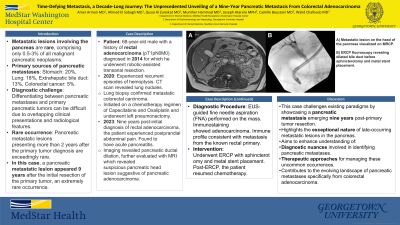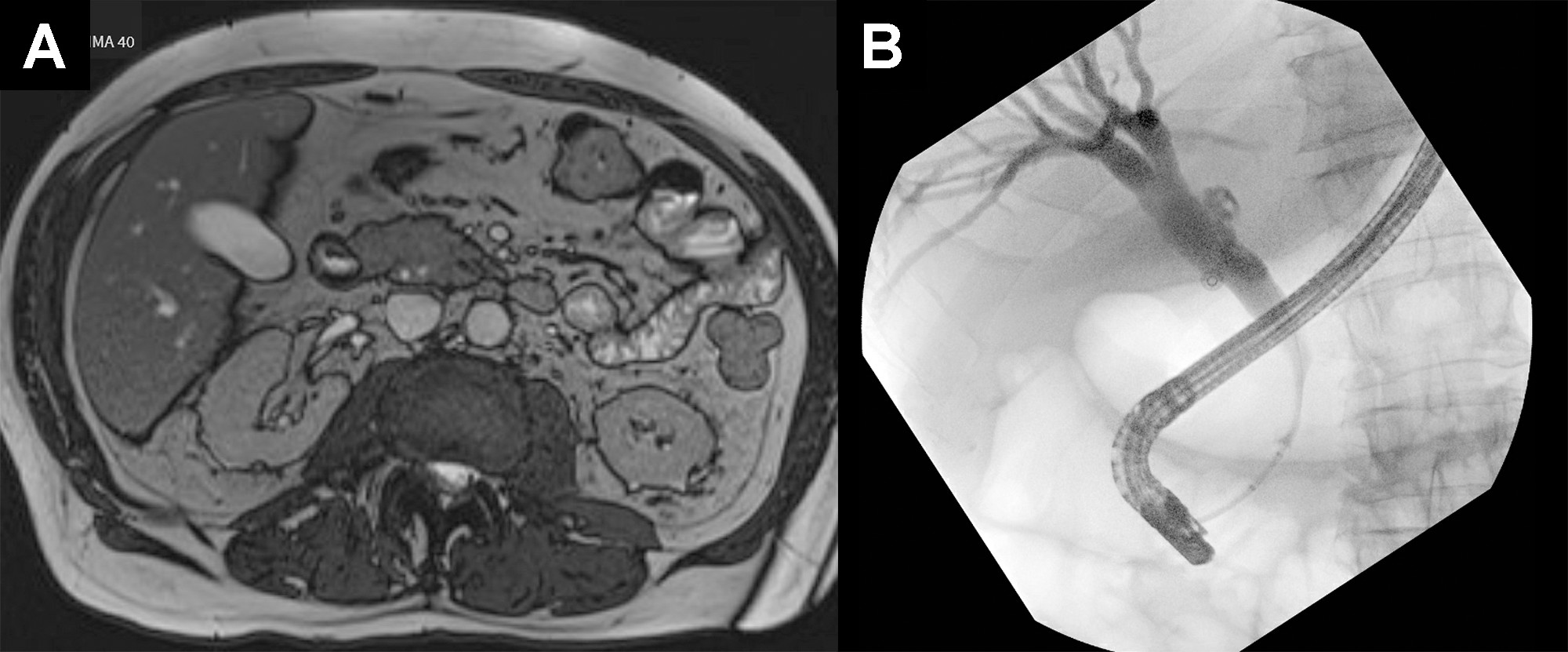Tuesday Poster Session
Category: Colon
P3723 - Time-Defying Metastasis, a Decade-Long Journey: The Unprecedented Unveiling of a Nine-Year Pancreatic Metastasis From Colorectal Adenocarcinoma
Tuesday, October 29, 2024
10:30 AM - 4:00 PM ET
Location: Exhibit Hall E

Has Audio

Amer Arman, MD
MedStar Georgetown University Hospital
Washington, DC
Presenting Author(s)
Amer Arman, MD1, Ahmed El Sabagh, MD1, Qusai Al Zureikat, MD2, Munther Hammad, MBBS1, Joseph Atarere, MD, MPH3, Camille Boustani, MD1, Chalhoub Walid, MD1
1MedStar Georgetown University Hospital, Washington, DC; 2MedStar Health-Georgetown/Washington Hospital Center, Washington, DC; 3MedStar Union Memorial Hospital, Baltimore, MD
Introduction: Metastatic lesions involving the pancreas are relatively rare, accounting for a mere 0.5-3% of all malignant pancreatic neoplasms. The predominant primary sources of these metastatic lesions to the pancreas include the stomach (20%), followed closely by the lung (18%) and extrahepatic bile duct (13%), while colorectal cancer accounts for only (5%).
Distinguishing between pancreatic metastases and primary pancreatic tumors can pose a diagnostic challenge, given the clinical presentations and radiological characteristics often overlap in both primary and secondary neoplasms. Notably, the presentation of pancreatic metastatic lesions more than 2 years after the initial diagnosis of the primary tumor is exceedingly rare. In our presented case, an exceedingly rare occurrence is observed, where a pancreatic metastatic lesion surfaced a remarkable 9 years following the initial resection of the primary tumor.
Case Description/Methods: We present a 68-year-old male with a past medical history of rectal adenocarcinoma pT1pN0M0 in 2014 for which he underwent robotic assisted transanal resection. Six years later in 2020, he experienced recurrent episodes of hemoptysis for which a CT scan revealed nodules in the lung. A subsequent lung biopsy confirmed metastatic colorectal carcinoma. He was started on a chemotherapy regimen consisting of Capecitabine and Oxaliplatin and eventually underwent left pneumonectomy.
In 2023, nine years after the initial diagnosis of rectal adenocarcinoma, he experienced postprandial abdominal pain. He was found to have acute pancreatitis and imaging incidentally revealed pancreatic ductal dilation, which was further evaluated with an MRI. This disclosed a pancreatic head lesion suspicious of pancreatic adenocarcinoma. An EUS-guided FNA with immunostaining of the mass showed adenocarcinoma and the immune profile was consistent with metastasis from patient's known rectal primary. He developed obstructive jaundice and subsequently underwent an ERCP with sphincterotomy and metal stent placement. Following the ERCP, he started on chemotherapy.
Discussion: This case challenges existing paradigms, highlighting the exceptional nature of a pancreatic metastasis emerging nine years post-primary tumor resection. As we delve into the intricacies of such cases, we aim to enhance our understanding of the diagnostic nuances and therapeutic approaches for these uncommon occurrences, contributing to the evolving landscape of pancreatic metastases from colorectal adenocarcinoma.

Disclosures:
Amer Arman, MD1, Ahmed El Sabagh, MD1, Qusai Al Zureikat, MD2, Munther Hammad, MBBS1, Joseph Atarere, MD, MPH3, Camille Boustani, MD1, Chalhoub Walid, MD1. P3723 - Time-Defying Metastasis, a Decade-Long Journey: The Unprecedented Unveiling of a Nine-Year Pancreatic Metastasis From Colorectal Adenocarcinoma, ACG 2024 Annual Scientific Meeting Abstracts. Philadelphia, PA: American College of Gastroenterology.
1MedStar Georgetown University Hospital, Washington, DC; 2MedStar Health-Georgetown/Washington Hospital Center, Washington, DC; 3MedStar Union Memorial Hospital, Baltimore, MD
Introduction: Metastatic lesions involving the pancreas are relatively rare, accounting for a mere 0.5-3% of all malignant pancreatic neoplasms. The predominant primary sources of these metastatic lesions to the pancreas include the stomach (20%), followed closely by the lung (18%) and extrahepatic bile duct (13%), while colorectal cancer accounts for only (5%).
Distinguishing between pancreatic metastases and primary pancreatic tumors can pose a diagnostic challenge, given the clinical presentations and radiological characteristics often overlap in both primary and secondary neoplasms. Notably, the presentation of pancreatic metastatic lesions more than 2 years after the initial diagnosis of the primary tumor is exceedingly rare. In our presented case, an exceedingly rare occurrence is observed, where a pancreatic metastatic lesion surfaced a remarkable 9 years following the initial resection of the primary tumor.
Case Description/Methods: We present a 68-year-old male with a past medical history of rectal adenocarcinoma pT1pN0M0 in 2014 for which he underwent robotic assisted transanal resection. Six years later in 2020, he experienced recurrent episodes of hemoptysis for which a CT scan revealed nodules in the lung. A subsequent lung biopsy confirmed metastatic colorectal carcinoma. He was started on a chemotherapy regimen consisting of Capecitabine and Oxaliplatin and eventually underwent left pneumonectomy.
In 2023, nine years after the initial diagnosis of rectal adenocarcinoma, he experienced postprandial abdominal pain. He was found to have acute pancreatitis and imaging incidentally revealed pancreatic ductal dilation, which was further evaluated with an MRI. This disclosed a pancreatic head lesion suspicious of pancreatic adenocarcinoma. An EUS-guided FNA with immunostaining of the mass showed adenocarcinoma and the immune profile was consistent with metastasis from patient's known rectal primary. He developed obstructive jaundice and subsequently underwent an ERCP with sphincterotomy and metal stent placement. Following the ERCP, he started on chemotherapy.
Discussion: This case challenges existing paradigms, highlighting the exceptional nature of a pancreatic metastasis emerging nine years post-primary tumor resection. As we delve into the intricacies of such cases, we aim to enhance our understanding of the diagnostic nuances and therapeutic approaches for these uncommon occurrences, contributing to the evolving landscape of pancreatic metastases from colorectal adenocarcinoma.

Figure: A) Metastatic lesion on the head of the pancreas visualized on MRCP.
B) ERCP fluoroscopy revealing dilated bile duct before sphincterotomy and metal stent placement.
B) ERCP fluoroscopy revealing dilated bile duct before sphincterotomy and metal stent placement.
Disclosures:
Amer Arman indicated no relevant financial relationships.
Ahmed El Sabagh indicated no relevant financial relationships.
Qusai Al Zureikat indicated no relevant financial relationships.
Munther Hammad indicated no relevant financial relationships.
Joseph Atarere indicated no relevant financial relationships.
Camille Boustani indicated no relevant financial relationships.
Chalhoub Walid indicated no relevant financial relationships.
Amer Arman, MD1, Ahmed El Sabagh, MD1, Qusai Al Zureikat, MD2, Munther Hammad, MBBS1, Joseph Atarere, MD, MPH3, Camille Boustani, MD1, Chalhoub Walid, MD1. P3723 - Time-Defying Metastasis, a Decade-Long Journey: The Unprecedented Unveiling of a Nine-Year Pancreatic Metastasis From Colorectal Adenocarcinoma, ACG 2024 Annual Scientific Meeting Abstracts. Philadelphia, PA: American College of Gastroenterology.
